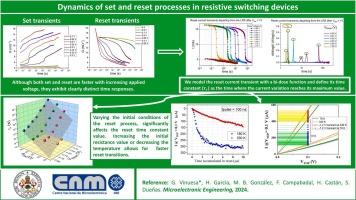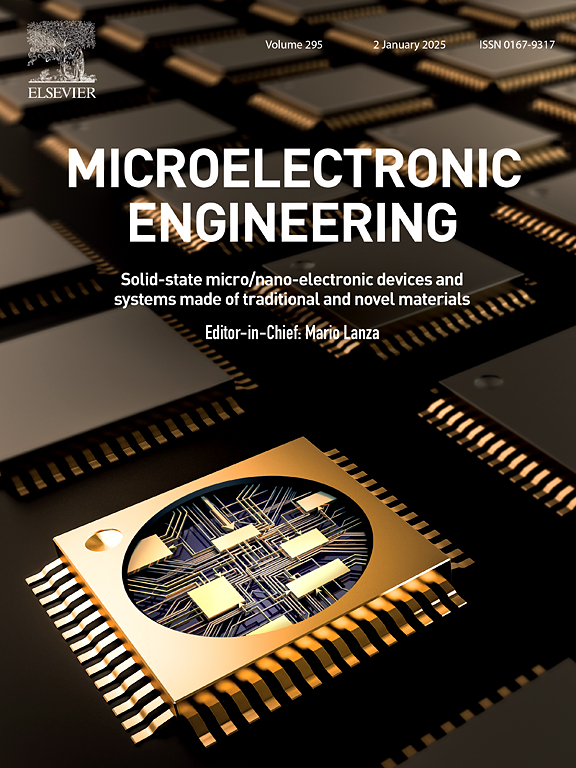基于 HfO2 的双极电阻开关器件中的设定和复位过程的动态变化
IF 3.1
4区 工程技术
Q2 ENGINEERING, ELECTRICAL & ELECTRONIC
引用次数: 0
摘要
我们深入研究了表现出电阻开关行为的 TiN/Ti/HfO2/W 金属绝缘体-金属器件中设定和复位过程的时间演变。为此,我们通过施加不同的电压来记录瞬态电流,从而改变器件的电导率。虽然设定和复位转换随着施加电压的增加而加快,但它们明显表现出不同的时间响应。设定转换的特点是电流值在最初突然上升后单调上升,而复位转换的特点则是明显的非线性响应,类似于正余弦函数。我们成功地用双剂量函数模拟了复位电流瞬态,并将其时间常数(复位时间)定义为电流变化达到最大值的时间。我们的研究结果表明,改变复位过程的初始条件(如提高温度和/或降低初始电阻值)会显著影响复位瞬态,并以指数形式增加复位时间常数值。因此,我们可以用平面方程来模拟其相关性。本文章由计算机程序翻译,如有差异,请以英文原文为准。

Dynamics of set and reset processes in HfO2 -based bipolar resistive switching devices
The temporal evolution of the set and reset processes in TiN/Ti/HfO2/W metal-insulator-metal devices exhibiting resistive switching behavior is investigated in depth. To this end, current transients were recorded by applying different voltages, which allowed us to change the conductance of the device. While both set and reset transitions are faster with increasing applied voltage, they clearly exhibit different time responses. The set transition is characterized by a monotonic increase in current after a sudden initial rise in its value, while the reset transition is characterized by a notably nonlinear response that resembles a sigmoidal function. We have successfully modeled the reset current transient with a bi-dose function and defined its time constant (Time-to-Reset) as the time where the current variation reaches its maximum value. Our findings show that varying the initial conditions of the reset process, such as increasing the temperature and/or decreasing the initial resistance value, significantly affect the reset transient, exponentially increasing the reset time constant value. This allows us to model its dependencies with the equation of a plane.
求助全文
通过发布文献求助,成功后即可免费获取论文全文。
去求助
来源期刊

Microelectronic Engineering
工程技术-工程:电子与电气
CiteScore
5.30
自引率
4.30%
发文量
131
审稿时长
29 days
期刊介绍:
Microelectronic Engineering is the premier nanoprocessing, and nanotechnology journal focusing on fabrication of electronic, photonic, bioelectronic, electromechanic and fluidic devices and systems, and their applications in the broad areas of electronics, photonics, energy, life sciences, and environment. It covers also the expanding interdisciplinary field of "more than Moore" and "beyond Moore" integrated nanoelectronics / photonics and micro-/nano-/bio-systems. Through its unique mixture of peer-reviewed articles, reviews, accelerated publications, short and Technical notes, and the latest research news on key developments, Microelectronic Engineering provides comprehensive coverage of this exciting, interdisciplinary and dynamic new field for researchers in academia and professionals in industry.
 求助内容:
求助内容: 应助结果提醒方式:
应助结果提醒方式:


